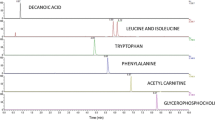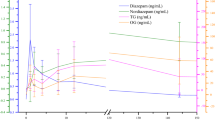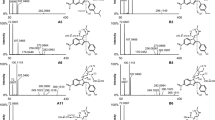Abstract
Quantification of drug metabolites in biological samples has been of great interest in current pharmaceutical research, since metabolite concentrations and pharmacokinetics can contribute to a better understanding of the toxicity of drug candidates. Two major categories of Phase II metabolites, glucuronide conjugates and glutathione conjugates, may cause significant drug toxicity and therefore require close monitoring at early stages of drug development. In order to achieve high precision, accuracy, and robustness, stable isotope-labeled (SIL) internal standards (IS) are widely used in quantitative bioanalytical methods using liquid chromatography and tandem mass spectrometry (LC–MS/MS), due to their capability of compensating for matrix effects, extraction variations and instrument response fluctuations. However, chemical synthesis of SIL analogues of Phase II metabolites can often be very difficult and require extensive exploratory research, leading to higher cost and significant delays in drug research and development. To overcome these challenges, we have developed a generic method which can synthesize SIL analogues of Phase II metabolites from more available SIL parent drugs or SIL conjugation co-factors, using in vitro biotransformation. This methodology was successfully applied to the bio-generation of SIL glucuronide conjugates and glutathione conjugates. The method demonstrated satisfactory performance in both absolute quantitation and assessment of relative exposure coverage across species in safety tests of drug metabolites (MIST). This generic technique can be utilized as an alternative to chemical synthesis and potentially save time and cost for drug research and development.



Similar content being viewed by others
References
Nicholson JK et al (2002) Metabonomics: a platform for studying drug toxicity and gene function. Nat Rev Drug Discov 1(2):153–161
Baillie TA et al (2002) Drug metabolites in safety testing. Toxicol Appl Pharmacol 182(3):188–196
Hastings KL et al (2003) Drug metabolites in safety testing. Toxicol Appl Pharmacol 190(1):91–92, author reply 93–4
Leclercq L et al (2009) Which human metabolites have we MIST? Retrospective analysis, practical aspects, and perspectives for metabolite identification and quantification in pharmaceutical development. Chem Res Toxicol 22(2):280–293
FDA, U.S. (2008) Guidance for industry: safety testing of drug metabolites
ICH (2009) Guidance on nonclinical safety studies for the conduct of human clinical trials and markering authorization for pharmaceuticals M3 (R2). Guidance on nonclinical safety studies for the conduct of human clinical trials and markering authorization for pharmaceuticals M3 (R2)
Atrakchi AH (2009) Interpretation and considerations on the safety evaluation of human drug metabolites. Chem Res Toxicol 22(7):1217–1220
Gao H, Obach RS (2011) Addressing MIST (Metabolites in Safety Testing): bioanalytical approaches to address metabolite exposures in humans and animals. Curr Drug Metab 12(6):578–586
Vishwanathan K et al (2009) Obtaining exposures of metabolites in preclinical species through plasma pooling and quantitative NMR: addressing metabolites in safety testing (MIST) guidance without using radiolabeled compounds and chemically synthesized metabolite standards. Chem Res Toxicol 22(2):311–322
Gao H, Deng S, Obach RS (2010) A simple liquid chromatography-tandem mass spectrometry method to determine relative plasma exposures of drug metabolites across species for metabolite safety assessments. Drug Metab Dispos 38(12):2147–2156
Gao H, Obach RS (2012) A simple liquid chromatography-tandem mass spectrometry method to determine relative plasma exposures of drug metabolites across species for metabolite safety assessments (metabolites in safety testing). II application to unstable metabolites. Drug Metab Dispos 40(7):1290–1296
Ma S et al (2010) Determination of exposure multiples of human metabolites for MIST assessment in preclinical safety species without using reference standards or radiolabeled compounds. Chem Res Toxicol 23(12):1871–1873
Faber H, Vogel M, Karst U (2014) Electrochemistry/mass spectrometry as a tool in metabolism studies—a review. Anal Chim Acta 834:9–21
Li P et al (2013) Bio-generation of stable isotope labeled internal standards for absolute and relative quantitation of drug metabolites in plasma samples by LC-MS/MS. J Chromatogr B Analyt Technol Biomed Life Sci 926:92–100
Ritter JK (2000) Roles of glucuronidation and UDP-glucuronosyltransferases in xenobiotic bioactivation reactions. Chem Biol Interact 129(1–2):171–193
Shipkova M et al (2003) Acyl glucuronide drug metabolites: toxicological and analytical implications. Ther Drug Monit 25(1):1–16
van Bladeren PJ (2000) Glutathione conjugation as a bioactivation reaction. Chem Biol Interact 129(1–2):61–76
Monks TJ et al (1990) Glutathione conjugate mediated toxicities. Toxicol Appl Pharmacol 106(1):1–19
Broach B, Gu X, Bar-Peled M (2012) Biosynthesis of UDP-glucuronic acid and UDP-galacturonic acid in Bacillus cereus subsp. cytotoxis NVH 391–98. FEBS J 279(1):100–112
Yang T et al (2012) In-microbe formation of nucleotide sugars in engineered Escherichia coli. Anal Biochem 421(2):691–698
Little JM et al (1997) Glucuronidation of all-trans-retinoic acid and 5,6-epoxy-all-trans-retinoic acid. Activation of rat liver microsomal UDP-glucuronosyltransferase activity by alamethicin. Drug Metab Dispos 25(1):5–11
Fisher MB et al (2000) In vitro glucuronidation using human liver microsomes and the pore-forming peptide alamethicin. Drug Metab Dispos 28(5):560–566
FDA (2001) Guidance for industry: bioanalytical method validation
Author information
Authors and Affiliations
Corresponding author
Electronic supplementary material
Below is the link to the electronic supplementary material.
ESM 1
(PDF 142 kb)
Rights and permissions
About this article
Cite this article
Li, P., Li, Z., Beck, W.D. et al. Bio-generation of stable isotope-labeled internal standards for absolute and relative quantitation of phase II drug metabolites in plasma samples using LC–MS/MS. Anal Bioanal Chem 407, 4053–4063 (2015). https://doi.org/10.1007/s00216-015-8614-5
Received:
Revised:
Accepted:
Published:
Issue Date:
DOI: https://doi.org/10.1007/s00216-015-8614-5




